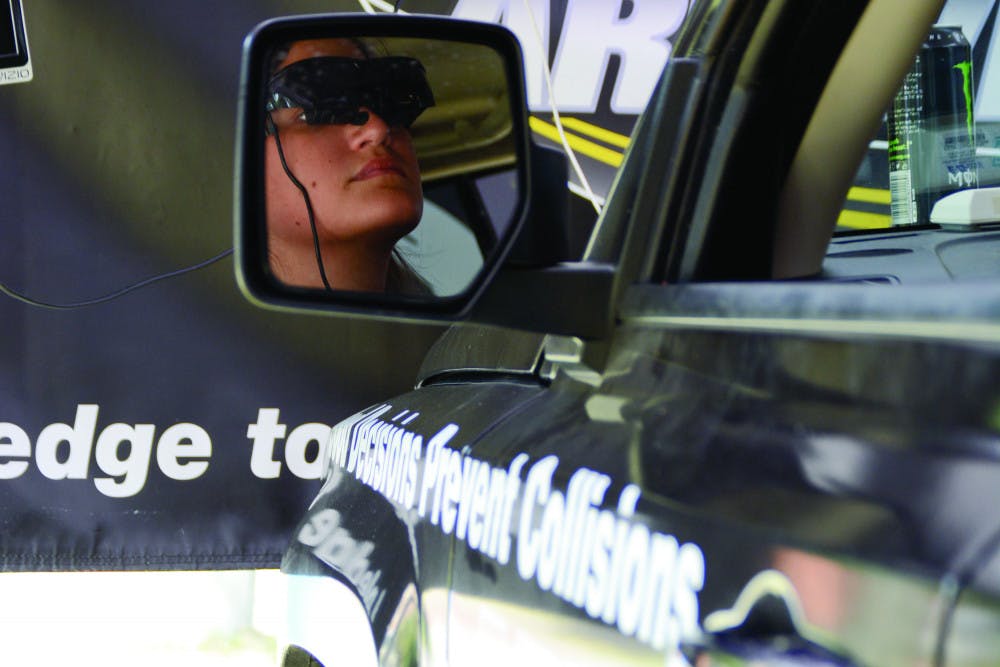Behind the wheel with a 0.12
By Paige Levin, Alligator Contributing Writer
The first time I drove drunk, I swerved within 10 seconds of getting behind the wheel and crashed into a parked car.
Luckily, I was in the middle of the Plaza of the Americas, under a tent, inside a parked truck and driving through the eyes of virtual goggles, so I got a second chance. Had I not been participating in UNITE’s Arrive Alive Tour virtual-reality program Monday, my fate may have been different.
The Arrive Alive Tour visited UF’s campus Monday and stationed itself on the Plaza of the Americas so students could experience drunk or distracted driving through its virtual-reality program.
The experience went a little something like this: I got into the car just like I normally would (sans seat belt, however — what drunk person would think to use that?). I put on my virtual-reality goggles and was instantly transported from the green plaza to the snow-covered mountains of Colorado.
An Arrive Alive representative asked me how drunk I wanted to be the way a waiter asks you what you want to drink. “How many drinks should we say you had in a two hour time period? Four? Five? Do you think you could do six?”
After inputting my information into the system, the computer calculated that my imaginary blood alcohol content was 0.12 g/dL, meaning there were .12 grams of alcohol for every deciliter of blood. To put it into perspective: The legal limit in most states is 0.08, but most accidents happen between 0.06 g/dL and 0.10.
That’s what most people might call “tipsy.”
The wheel felt stiff, but I was swerving uncontrollably from side to side. I don’t think I stayed in the correct lane for more than five seconds. On my second try, I didn’t drive more than 10 mph, ignoring the 45-mph speed limit. Yet, I crashed my car within 30 seconds.
Afterward, I was handed a ticket for swerving, driving below the posted speed, driving on the incorrect side of the road and collision.
“At least you didn’t get marked for vehicular manslaughter,” the representative commented.
It all reminded me of Crazy Taxi, a video game many played as kids. The scary part is that most of the time, this isn’t a game.
The perils of distracted driving
By Giuseppe Sabella, Alligator Contributing Writer
Much to the cones’ dismay, Cpl. Gerry Hunter of the Gainesville Police Department covered my eyes while I drove a black Chevrolet Impala at 35 mph Friday.
Hunter, among other off-duty officers, led a distracted driving course as part of an ongoing study by Pentagon Communications, a student-run public relations group at UF.
And, no, it was not a simulator. I was driving an actual car on a closed course packed with vulnerable traffic cones at Santa Fe College’s Institute of Public Safety.
The expanse of concrete and orange cones resembled my high school driver’s ed class, minus the teacher having access to the brakes and steering wheel.
A clipboard obscured my vision as I gripped the steering wheel, took a deep breath and barreled down a runway of cones in the first obstacle.
Hunter removed the clipboard as I approached a wall of cones and sprinklers, which were meant to represent pedestrians on a road slick from rain.
Tires screeched as I harnessed my inner stunt driver, swerving right and avoiding the cones.
But my confidence dropped while navigating tight, weaving bends in the last two obstacles, which simulated a parking lot or crowd of people.
The death toll of cones increased when my iPhone began to ping, and I answered text messages like, “Are you here yet?? Bring coke!” “Also, can you bring ice?”
Ignoring the welfare of the cones, I texted back.
Pentagon Communications plans to use its observations from the course, combined with focus groups and online survey results, to create a no-texting-while-driving campaign for GPD.
Kayla Ellsworth, the principal investigator for Pentagon Communications, said they hope to change how younger generations view texting and driving.
She also wants to make texting while driving a primary offense, rather than secondary, which doesn’t allow officers to pull someone over solely for texting.
At the end of the course, I left with a strange sense of satisfaction from an officer praising me for my reckless driving.
“Good job,” Hunter said.
However, I do want to give a shout-out to the fallen cones that lost their lives during my excursion.
Brittany Hammer, a 21-year-old UF finance senior, demonstrates how to use UF organization Nightlife Navigators’ drunk driver simulator. Hammer, Nightlife Navigators’ vice chair of outreach, collided multiple times with cars and pedestrians during the simulation.






